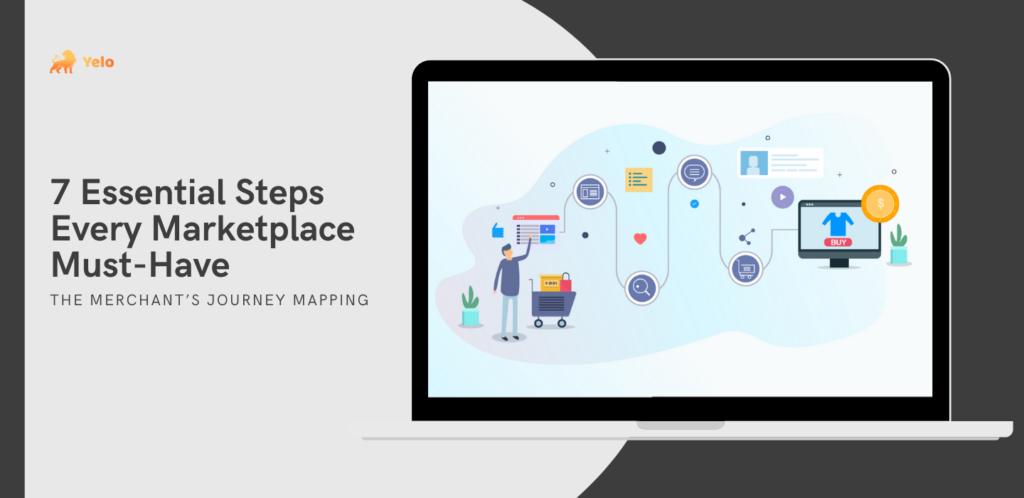
- Products
- Solutions
- Learn
- Partner
- Try Now

Every online marketplace has two key contributors – buyers and sellers (merchants). Many eCommerce marketplaces work hard on their user interface to create an excellent Merchant journey mapping from the onboarding to the final checkout page. For the execution of a fantastic customer journey, an online marketplace needs mapping of each phase.
Similarly, the eCommerce marketplace also needs to have a well-designed merchant journey mapping approach. It can help your marketplace attract more merchants or sellers and, in turn, a higher number of buyers with more products on the platform. Such a strategy can also help you solve the chicken and egg problem that many marketplaces face.
According to digitaleCommerce360, online marketplaces account for 57% of the total online retail sales worldwide. Online marketplace markets saw revenues close to $2 trillion in 2019. The top 100 marketplaces dominate the market, and the reason for their success is a correctly mapped merchant journey. So, let’s understand what merchant journey mapping is and the seven steps to creating a compelling journey for merchants on your platform.
What is Merchant Journey Mapping?
A Merchant Journey Mapping is a roadmap of engagement for sellers on your marketplace. It is not just about improving the touchpoints where merchants interact with your platform, but also about creating an experience and ease of doing business.
Mapping merchant engagement journeys helps you create reliable partnerships for achieving your goals for an online marketplace. Another essential aspect is the value proposition.
Merchants need to see the value in your online marketplace, which incentivizes them. For an online marketplace, value proposition depends on the number of customers that use their platform for buying products.
Through a mapped merchant journey, you can ensure higher visibility of each seller on your platform. With more visibility, merchants find more value on your platform.
From registration on your platform to listing products, setting up the product pages, payment gateways, customer support, technical help, and delivery management, every aspect should be considered for merchant journey mapping.
So, let’s discover the seven steps to a successful merchant journey mapping for your online marketplace.
#1. Listing – Location and Phone Number
Product listings are among the essential elements of any online marketplace, as they enable merchants to showcase their products and services. The process should be streamlined to quickly bring merchants from the registration of products to the listing charges.
If you are a new online marketplace, initially, you can refrain from charging your merchants on the listing of products and maybe earn from sales commissions. It encourages new merchants to come aboard, increasing the product catalogue on your platform.
For example, Etsy charges as low as $0.20 per listing for every merchant on an online marketplace platform. It helps merchants with a low startup budget too. However, there are some downsides to this pricing structure, which you can avoid; like Etsy offers individual listing for a fee. If you are selling products a pack of, say, ten items, you are charged $0.20, while if sold individually, you may end up paying $2.
Another aspect is offering your merchant complete consumer data for effective real-time communications. A smart solution that enables features like geo-fencing and real-time navigational tools can enhance your online marketplace to provide consumers with better location data.
#2. Cataloguing
Catalogue-building depends on the kind of technical support you offer on the platform and charges per listing. For example, if you are charging for individual products, cataloguing more items may increase costs. Merchant journey mapping should consider catalogue-building a vital touchpoint to enhance the merchant’s experience.
Some online marketplaces even have separate collection catalogues for niche products, and it should be a part of your merchant journey mapping. Another essential aspect is promoting such collections and advertising charges to intimate the merchants upfront to reduce friction.
#3. Chat Support
Merchants that sell products on your online marketplace platform need practical customer support features. Not only for the communication of merchants with the platform tech support, but this feature should also enable customer support for users. The platform can act as a medium for users to interact with merchants regarding their product issues through a reliable chat support feature.
Effective chat support can also be an excellent addition to customer journey mapping. So, you can quickly achieve higher customer satisfaction and facilitate merchants to connect with the end-user through instant chat features on the marketplace apps or web portal.
#4. Ease of Payments
One of the key factors that attract merchants to sell products on your platform is revenues. The first thing that you should ensure to create better merchant journeys is the ease of revenue sharing. When you facilitate instant revenue sharing, small-scale merchants can survive through regular cash influx.
Apart from the revenue sharing, the payment processing fees can be minimum. Many online marketplace platforms charge merchants for payment processing. It can be a double blow on the merchant’s budget, with commission charges and payment processing fees. Many Online Marketplace platforms like Yelo, Amazon do not charge specific payment processing fees, while Shopify and Etsy do charge merchants to use their in-house processors.
#5. Delivery Management
Merchant journey mapping also needs excellent delivery management to enable the reach of products to the end-users. Most of the marketplaces need to have excellent last-mile delivery services. The last phase of any delivery management deals with product deliveries from distribution hubs to the user’s locations.
Delivery management enables your merchant to deliver different products to the customers on your platform and avoid revenue shortcomings due to returns. According to a survey for top reasons for which customers return products, 20% amounts to damaged products delivery, while 23% amounts to wrong item delivery.
So, efficacy in delivery management can help you with enhanced merchant journeys, as they will not have to go through the hassle of replacing items.
#6. Marketing & Analytics
Apart from the operational support of listings, payments, and delivery management, marketing of the platform’s products is also a critical part of your merchant journey mapping. It allows your merchants to promote their products on the platform and other associated social accounts. You can even design unique campaigns and giveaways as a part of promotional partnerships with key merchants with the right Online Marketplace Platform features in Place.
Take an example of Prime Day exclusive launches offered by Amazon to several merchants on the platform. Some of the sponsored brands saw a 105% increase in Prime Day Sale’s revenues in 2020.
At the same time, analytics can help merchants track orders, the performance of product categories or specific products, revenues, and traffic on their official product page. It helps your merchants track their performance, and enables them to reflect on the concerns.
#7.Branding
Another aspect of merchant journey mapping is the awareness among customers regarding the products a seller’s offers on your online marketplace platform; which can be increased through branding. It helps merchants on the marketplace attract more customers by improving the brand value.
According to Oberlo, consistent branding can improve revenues by up to 33%. Online marketplace platforms can enable merchants with consistent branding on their platform and multi-channel marketing to improve brand visibility.
A merchant journey mapping requires planning for all these factors to enhance the existing marketplace platform and make the seller onboarding process smoother. There are many online marketplace solutions to help you in merchant journey mapping and integrate it into your platform’s business model. Yelo is one such online marketplace software solution that helps with merchant journey mapping.
What is Yelo?
Yelo is an online marketplace solution that offers smart features for your business. It enables merchant journey mapping and integration of specific tools to enhance the entire process. For example, Yelo offers features like approval-based listings, geo-fencing, and customisable static pages to provide better product listing pages.
At the same time, it offers unique tools for cataloguing, advanced product search, and automation of last-mile delivery services. You can not only create an excellent merchant journey mapping strategy but also execute it effectively with Yelo.
Conclusion
The merchant’s journey depends on how easily they can engage with the platforms and sell products on your marketplace. From the time a merchant registers with the online marketplace, to the point where the product gets delivered, merchant journey mapping can help you identify all the critical touchpoints. Adapting your online marketplace with the merchant journey roadmap will help you attract more sellers, and the product catalogue will grow, which will help your marketplace grow.
Sign up for Yelo’s 14 days free trial and explore for yourself.
Subscribe to stay ahead with the latest updates and entrepreneurial insights!

Subscribe to our newsletter
Get access to the latest industry & product insights.





















